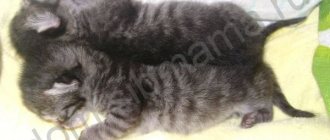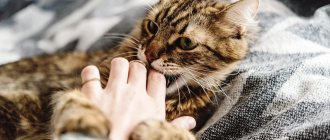When a cat gives birth to a dead kitten, this is a signal that you need to find out what reasons provoked this development of events. This will allow you to prevent the repetition of an unpleasant situation in the future, and sometimes even save the cat itself. Immediately after the birth of kittens, you can try to bring them back to life, following generally accepted rules. It is important to understand that the risks of stillbirth in purebred cats are higher than in outbred cats. These are the statistics.
First aid for newborns
Among domestic cats, stillbirth is not uncommon. Even under satisfactory housing conditions, the percentage of stillborn kittens ranges from 4 to 15%.
Very often, the reason why a cat’s kittens die is the inexperience and illiteracy of the animal owner. Often, newly born babies may seem lifeless. Newborns may not move or make any sounds and are often mistaken for stillborn. However, competently carried out resuscitation measures can save the baby’s life:
- First of all, it is necessary to free the kitten from the shell, this will allow him to breathe on his own.
- The umbilical cord should be pinched with your fingers at a distance of 2 cm from the tummy for a few seconds (squeezing the blood vessels) and cut with sterile scissors. The wound should be treated with an antiseptic.
Scissors, gauze pads and antiseptic are the necessary materials for giving birth to a cat.
- Your baby's nose and mouth may become clogged with mucus. In this case, it is necessary to empty the oral cavity and nasal passage using a small syringe.
Diapers and a syringe are important tools.
- After this manipulation, the cub is wrapped in a waffle towel and tilted head down to remove the remaining mucus.
- Mouth-to-mouth artificial respiration helps to revive weak kittens. This should be done with the help of devices: a straw, a small syringe, etc. You need to blow air into the mouth at intervals of 3 - 5 seconds in small portions, taking into account the size of his lungs.
- Carefully licking her kittens, the mother cat, at the level of instinct, carries out resuscitation of the weak cub. The owner can also imitate this behavior by using fingers wrapped in a sterile cloth for massage. Massage movements should be carried out on the head (from the forehead to the back), along the torso (from the tail to the neck) and on the tummy (in circular movements from the chest to the perineum). Manipulations should be carried out intensively.
- At home, ammonia has been successfully used to revive kittens. A cotton wool soaked in the preparation should be brought to the baby’s nose several times.
You should know that resuscitation measures can be carried out for no more than 5 - 7 minutes if there is no heartbeat, and no more than 20 minutes if there is a heart rhythm. We recommend reading the article about when you can sterilize a cat. From it you will learn about the best age to sterilize a cat and about periods in an animal’s life when sterilization should be delayed.
[custom_ads_shortcode1]
Problems that may arise when giving birth to a cat
The table below highlights the most common problems that arise during the birthing process in cats and kittens, which the owner can overcome on their own.
Stage What's happening
Contractions have stopped or become weak
You need to wait some time. When 1-2 kittens are born, labor may subside and then reactivate (in some cases it can take up to a day). Labor can be stimulated by massaging the mammary glands and nipples. In extreme cases, it is possible to use oxytocin, a drug that promotes contractions of the uterine wall. It should be borne in mind that improper use of the product can cause the death of the mother and offspring.
The membrane remained intact
If the mustachioed mother has not torn the membrane of the amniotic sac, you need to carefully tear it apart, starting from the kitten's face.
The cub can't get out
If the baby gets stuck in the birth canal, the owner will have to help him: to do this, grab the kitten by the skin (on the withers or back of the body) and slowly pull it out. Manipulation should be carried out wearing gloves, the tips of which should be lubricated with Vaseline oil.
The umbilical cord remained intact
If the woman in labor has not gnawed the umbilical cord, and more than a quarter of an hour has passed since the kitten was born, it is necessary to do the following: step back from the kitten’s tummy about 4 cm, bandage or clamp it, and after half a minute cut it at the point of compression. The incision site must be treated with an antiseptic (brilliant).
Newborn is not breathing
You can try to gently shake it, lowering its muzzle down. A sign of oxygen entering the respiratory system is the pink color of the newborn’s tongue. In addition, it should make a squeaking noise.
Cat ignores baby
In this case, the owner must carry out the initial treatment of the kitten. It is necessary to wipe the newborn with a cloth and remove mucus from the respiratory tract using a syringe. After this, you need to place the baby on the nipple.
Causes of stillbirth in cats
There are many reasons why an animal gives birth to dead kittens. Conventionally, they can be divided into the following groups: 1. Genetic causes. This is a large group of factors that directly affects the viability of the offspring and is the reason why a cat gives birth to dead kittens:
- Hereditary factor. If there are cases of stillbirth on the maternal and paternal lines of the mother cat, then the likelihood of stillbirth increases sharply.
- Genetic abnormalities of fetal development (mutations and deformities).
- Inbreeding (mating of closely related lines) is one of the common causes of stillbirth.
- Blood group incompatibility. When breeding, this factor must be taken into account, since parental incompatibility leads to hemolytic disease of the newborn and stillbirth.
To date, three blood groups :
| Formed through the following pair of genes: A/A or A/B , where A is the dominant gene and suppresses the properties of B |
| Very rare and not yet fully studied. Please note that AB is a completely different blood type than A/B |
| formed through I/V genes |
2. Adverse factors during pregnancy:
- Injuries during pregnancy. Blows and bruises, falls from a height of a pregnant female often lead to the birth of dead offspring.
- The presence of diseases of an infectious or parasitic nature in the mother or father (chlamydia, listeriosis, toxoplasmosis, herpes, panleukopenia, etc.) is a common reason why a cat gave birth to dead kittens. In this case, diseases in animals can be asymptomatic, without obvious clinical signs or in the form of virus carriage.
Herpes on a cat's lip.
- Inflammatory diseases of the female reproductive system. Metritis, endometritis, inflammatory processes in the genitourinary area lead to disruption of pregnancy, the supply of nutrients and oxygen to the babies in the womb.
- Poor nutrition and maintenance of a pregnant cat. An inadequate and low-calorie diet of the female, a lack of vitamins and minerals are common reasons why a cat gives birth to dead kittens. Lack of physical activity and physical inactivity lead to oxygen starvation of the fetus in the womb.
3. Adverse factors during childbirth. Quite often, the cause of stillbirth is deviations in normal labor:
- Complications during childbirth (incomplete dilatation of the birth canal, prolonged labor) lead to kittens suffocating as a result of strong pushing and delay in the birth canal.
- The animal owner's inexperience in determining its viability is also often the reason why the baby is mistakenly considered stillborn. This group of reasons also includes incorrect actions (or inaction) of the owner to revive the kitten.
4. Other factors. The reasons for the birth of stillborn kittens can be not only genetic diseases, illnesses and injuries, but also other factors that must be taken into account:
- Number of previous pregnancies. Very often, non-living offspring are born to a primiparous cat, as well as to an animal with a small number of pregnancies. The more often an animal gives birth, the less likely it is to give birth to stillborn kittens.
- Mother's weight. A large cat is more likely to give birth to a stillborn litter than an animal of average weight. This is due to the fact that a thick fatty layer of internal organs, including the uterus, leads to hypoxia of the fetus in the womb.
The variety of causes and factors leading to stillbirth makes diagnosis and preventive measures difficult.
[custom_ads_shortcode2]
Intrauterine death of kittens - causes and consequences
Most often, the reasons for the death of kittens before birth lie in intrauterine developmental disorders . Some embryos may die during multiple pregnancies. In this case, we can say that the body gets rid of excess load. In this case, the mother's body absorbs dead embryos. Congenital malformations that are incompatible with life may arise due to genetic defects or poor quality care for the mother in the early stages of pregnancy.
Quite often, intrauterine malformations are associated with chronic diseases of a pregnant cat . Constant stress, cold, physical damage, trauma and other external factors can lead to intrauterine death of kittens. It has been established that a deficiency of taurine in a cat's diet leads to a slowdown in the development of muscles and bones in fetuses. During cat pregnancy, it is not advisable to use any medications (especially toxic ones) without the prescription and supervision of a veterinarian.
Actions of the owner upon the birth of stillborn kittens
The owner of an animal is not always mentally prepared for the fact that childbirth ends in the birth of dead offspring. And the question of what to do if a cat’s kittens die is relevant in such a situation. First of all, the owner needs to carry out a series of resuscitation measures.
If the appropriate manipulations do not lead to the revival of the baby within 20 minutes, the animal can be considered dead. It must be isolated from the cat and wrapped in a plastic bag. If all kittens in a litter are stillborn, each corpse should be placed in a separate waterproof bag.
The owner's next step is to visit a veterinarian to autopsy the dead kittens and determine the cause of their death. As a rule, a pathological examination helps to identify causes of stillbirth such as: congenital anomalies in fetal development, infectious diseases, injuries during pregnancy and childbirth, etc.
After the mother cat has had a rest from giving birth, she and the father cat should also be shown to a veterinarian to determine the reasons that led to the birth of a stillborn offspring. Diagnostics will be aimed at identifying inflammatory processes in the cat’s reproductive system, incompatibility of blood groups, virus carriage or latent infection in both parents, etc.
[custom_ads_shortcode3]
Someone else's cat brought kittens - a sign with a hint
Stray animals often come to people for help. In this case, to show mercy is to earn a few “pluses for karma.” At a minimum, the guest should be fed. It’s even better to take her into your home; it will definitely be rewarded from above.
- The situation will be especially significant when a cat brings kittens to your doorstep - the sign says that the owners of the home can receive the right to the unconditional protection of heaven.
Purrs have increased sensitivity. Even out of complete despair, they will not fawn over a cruel, soulless person. In addition, these animals care more about their offspring than some people. They will certainly never expose their children to unnecessary risks.
- If a stray cat and kittens come into the house, the sign assures that this home is not in any danger. And vice versa: when a domestic cat strives to take the cubs out of the apartment, serious problems appear on the horizon.
Sometimes it happens that a neighbor’s purr comes to “visit” with her entire brood - she’s completely at home, not in need of rescue. You can’t drive her away, but you shouldn’t automatically take responsibility for your furry family.
- If someone else's cat brings kittens into your home, the sign recommends feeding her and leaving her alone, not holding her back, not imposing your “friendship,” and releasing her on demand.
In the old days they said that such “visitors” looked after their neighbors at the request of their deceased relatives.
Measures to prevent stillbirth in cats
Despite the variety of causes of stillbirth, you can significantly reduce the risk of stillbirth by following these tips:
- competent selection of parent pairs by breeders, taking into account the compatibility of blood groups and hereditary diseases;
- exclusion of closely related mating;
- diagnosis of latent infections of the parent couple before mating;
- vaccination according to the approved schedule of the parent couple;
- deworming (expulsion of worms and parasites) of the mother and father according to established periods before mating;
- exclusion from breeding of parents with developmental anomalies, mutations in the family;
- compliance with the norms and feeding regimen of a pregnant female;
- prevention of vitamin deficiencies, mineral deficiency;
- organizing proper maintenance for a pregnant cat (reducing stressful situations, organizing walks and active muscle activity);
- prevention of injuries during pregnancy.
Following these preventive measures will significantly reduce the risk of stillbirth in your cat.
The birth of dead kittens significantly overshadows a joyful event for the owner of a furry pet. An autopsy of stillborn offspring, diagnostic studies of a cat, and genetic analysis will help to understand the causes and factors of the sad event. Compliance with certain rules will help prevent and significantly reduce the risk of stillbirth in the future.
Among the reasons and factors are the following:
- Heredity. Mortality in the family (both maternal and paternal) greatly increases the likelihood of death.
- Genetic abnormalities. In the development of the fetus, deformities, mutations, and various disorders can be observed. Too frequent births, more than 2-3 times a year, can also lead to this.
- Imbreeding. If a closely related female and male mate, the life of the newborn kitten is at risk.
- Blood incompatibility. When breeding purebred cats, this is a key criterion. Blood type mismatches increase the risk of a stillborn kitten.
- Mutilation. Bumps and bruises, falls - these are factors characteristic of stray cats who are in constant danger. Painful contractions appear, and the cat may not give birth even in a day.
- Parasitic diseases. Individuals with chlamydia, toxoplasmosis, herpes, and inflammatory processes in the reproductive organs have little chance of a successful pregnancy outcome.
- Dietary disorders. The lack of the proper amount of vitamins and minerals interferes with the favorable development of the fetus and poses a threat to the life of the mother. The cat's activity decreases, and the fetus begins to become oxygen starved.
© shutterstock.
[custom_ads_shortcode1]
Signs that a cat has given birth completely
The belly of a giving birth cat, if it is assumed that all the kittens have come out, will be soft and without any lumps.
You need to feel it carefully, without using force. But it is impossible to judge the end of labor by the size of the abdomen, since the cat’s uterus contracts slowly, and even after a day retains its tone
The main guidelines indicating complete delivery are behavioral signs:
- The cat does not feel anxious, there are no attempts.
- The woman in labor is breathing smoothly, the heartbeat is rhythmic, the pulse is not rapid;
- The mother shows an active interest in the offspring, licks the kittens, feeds them, and moves them closer;
- She can change her body position, get up from the nest, and leave it for several minutes;
- After hard work, your pet feels increased appetite and thirst, eats and drinks with pleasure.
What to do if a kitten is born dead?
When a cat gives birth to dead kittens, it is mainly a moral blow for the owner. The first step is postpartum resuscitation measures. In some cases, this helps to save the kitten within 15-20 minutes after birth:
- The kitten should be turned down: the bubble is eliminated, which will leak bile from the mouth and lungs. Remains can be sucked out using a syringe.
- Two exhalations are made from the kitten’s mouth and nose. The mouth should completely cover the baby's face.
- You can check your heartbeat with a stethoscope. The chest is compressed with light pressure between the index finger and thumb.
As practice shows, if a cat gives birth to dead kittens, it is not possible to carry out resuscitation operations due to the lack of skills and appropriate equipment. In addition, we must not forget that diseases of a dead fetus can be transmitted to the cat's owner.
If there is no result, the dead baby is isolated from the mother and wrapped in a bag. When there is not one dead kitten, but several, each is isolated separately.
© shutterstock The second step is consultation with a veterinarian. The specialist will perform an autopsy of the dead fetus and identify the factors that influenced the death. The female and male (if possible) should be seen by a doctor after two to three days, when the cat has recovered from the birth. The veterinarian’s task is to identify or refute the presence of inflammation in the reproductive part of the body and, if necessary, prescribe treatment.
[custom_ads_shortcode2]
Who is at risk?
Kittens with low birth weight, or those who are not gaining weight or losing weight. Kittens smaller than 60 grams usually do not survive.
It usually develops in the first 3-5 days of life. The main causes are viral, bacterial infections, intestinal infections, poorly treated and inflamed umbilical cord and umbilical sepsis, aspiration of dirty amniotic fluid, impaired bottle feeding: either dirty, insufficiently sterilized or stale formula or improper feeding.
A normal kitten in the first days of life should have the following indicators: .
- Weight 70-110 grams at birth (depending on breed), temperature 36.5 – 36.7
- Glucose 4-7 mmol\l
- Heart rate per minute - 180-240
- Respiratory rate – per minute – 16-36
If you doubt whether everything is okay with the kids, check these indicators. In addition to glucose monitoring, anyone can do them.
If there are deviations, we sound the alarm. Particularly dangerous are low temperatures (hypothermia) and lack of oxygen (hypoxia). Further, as a result, the pressure drops (hypotension) and it is almost impossible to help such a heavy baby...
When visiting a veterinary clinic, you should choose large ones, preferably where there are specialists in neonatology and reproduction (veterinarian-reproductologist), because general practitioners are often not sufficiently versed in this area.
How to protect future offspring?
You can help your cat give birth to kittens alive and healthy through pregnancy prevention and preliminary preparation:
- competent choice of a male means compatibility of blood groups, absence of hereditary diseases and cases of stillbirth in ancestors;
- It is not recommended to allow mating of related individuals;
- periodic diagnostics of a pet will identify infectious formations and reproductive problems in advance;
- in a veterinary clinic you can carry out deworming - elimination of parasites and worms;
A cat needs care during pregnancy. This concerns nutrition and safety: the slightest injury can become critical for the fetus.
When a cat gives birth to a dead kitten, this is a signal that you need to find out what reasons provoked this development of events. This will allow you to prevent the repetition of an unpleasant situation in the future, and sometimes even save the cat itself. Immediately after the birth of kittens, you can try to bring them back to life, following generally accepted rules.
It is important to understand that the risks of stillbirth in purebred cats are higher than in outbred cats. These are the statistics.
[custom_ads_shortcode3]
Varieties and their symptoms
One of the types of miscarriages that pose the least danger to your pet is fetal resorption in the early stages of pregnancy. In fact, the process may go unnoticed by you. The fruits do not necessarily all dissolve; sometimes some of them continue to develop normally. Much more serious is intrauterine fetal death, which can occur at any stage of pregnancy.
As for intrauterine fetal death without miscarriage, this is the most serious problem. In this case, your pet begins to bleed heavily, as well as purulent discharge (key symptoms). In addition, the cat refuses food, begins to vomit, and the temperature rises. The only sure way out is to contact a specialist as soon as possible.
Research in the field
Veterinarians warn that the fact that one kitten was born does not indicate that the cat and its offspring are in danger. Often, pregnancy is multiple, so after a stillbirth, a cat can give birth to live babies.
Veterinary statistics collected over many years of practice indicate that the mortality rate among offspring of purebred cats is higher than that of outbred cats. At the same time, 7% of babies die in utero, 9% - until the 2nd week of life, 9% - 3 weeks or a month after birth. But only 75% of 4-month-old fluffy babies reach one year of age. According to general data, among pets of any breed, the number of cases where a cat gives birth to dead kittens is from 4 to 15%.
There is a small chance that some babies will be born dead or die soon after.
[custom_ads_shortcode2]
Important Notes
Firstly, we note that the fact of the birth of a stillborn kitten (even if it is the first) does not mean something catastrophically dangerous. Cats are prolific animals, and therefore, after a dead cub, they may well be born alive and healthy. Moreover, experienced breeders probably know that a certain percentage of waste always occurs.
Alas, inexorable veterinary statistics accumulated by practicing specialists around the world indicate that in purebred animals the risk of giving birth to dead kittens is always higher (and significantly) than in outbred “murks”. This is especially true for Persians: in some cases, up to 7% of kittens are born dead in pets of this breed, and another 9% of cubs die within the first week of life.
In general, it is the Persians who collect the most sad statistics: it is believed that if 75% of kittens are alive by the third week of life, then this is a very good result. It often happens that more than half of all newborns die. This deplorable situation is associated with a huge number of genetically transmitted diseases. There are cases where a third of the entire litter was born with severe liver pathologies (including the complete absence of this organ).
Secondly, it is necessary to distinguish between cases of stillbirth and infant death. Remember that in situations where a kitten dies within the first hours after birth (or even the first days), it is also customary to talk about “stillbirth”.
Thirdly, it is necessary to distinguish between situations when kittens were born dead, being still in the womb, and cases when the cubs, initially healthy (at least partially), died directly during the birth process.
Main predisposing factors
We list the most common causes of stillbirth encountered in veterinary practice:
- Hypoxia (lack of oxygen). This is a very common pathology in cases of protracted labor, when the kitten’s umbilical cord, which supplies its body with oxygen, is pinched in the birth canal. It is believed that in cases where a kitten remains in the birth canal for more than ten minutes, unable to be born, the risk of its death increases to almost 90%. Due to severe hypoxia, a kitten may be born alive, but you shouldn’t experience much joy from this: such pets often cannot even suck their mother’s milk. They subsequently develop serious developmental problems. As a rule, after some time they die anyway.
- Injuries received by babies directly during childbirth often lead to similar results. Studies have shown that cats with “extremes” of anatomical development (long-suffering Persians are especially “distinguished”) experience more problems during the birth process. Most likely, this is a consequence of the combination of the kittens’ large heads and narrow pelvises in cats of this breed.
- The percentage of stillborn kittens in litters of primiparous and old cats is much higher. Such animals are either inexperienced, or their body is not able to ensure the normal development of fruits. In addition, in old pets there are very frequent cases of severe uterine atony, which is why kittens are born for a long time, often getting “tightly” stuck in the birth canal.
It has been observed that cases of stillbirth are much more common in animals suffering from obesity. In addition, some cats produce milk long before birth, which (if it is not sucked out mechanically) leads to mastitis. Inflammation of the mammary glands significantly increases both the risk of stillbirth and the likelihood of infant death. Mastitis milk, saturated with decay products and pathogenic microflora, is not the best food for the delicate stomachs of kittens that have just been born.
Main provocateurs
The reasons why a kitten dies or all offspring die in the first hours or days of life include the following:
- Genetic factors: heredity, when there are cases of dead kittens being born in the parents’ family;
- developmental defects - mutations and deformities;
- contact with close relatives;
- incompatibility of feline blood types.
- injuries, falls from height;
- complications in the form of insufficient opening of the birth canal;
- the presence of successful pregnancies or absence, for example, for those who give birth for the first time, the risks of stillbirth are higher;
[custom_ads_shortcode3]
What is Neonatal Kitten Fading Syndrome? Techniques for managing severe neonates.
This syndrome is more described in puppies, less so in kittens.
Most often, this term has a reason - septicemia in newborn kittens, that is, the development of an infection in the body. Sometimes you can find the name “neonatal sepsis” or “newborn sepsis”.
Symptoms - refusal of milk, no sucking reflex - does not stick to the finger or nipple. Lethargic, inactive, unlike puppies, who constantly squeak, and kittens lie quietly and quickly develop disseminated intravascular coagulation syndrome, blood in the urine, nasal bleeding, vasodilation, impaired cardiac output, and septicemia.
First aid
If the owner has not previously helped the pet in this process, then he may consider a completely alive and simply inactive baby to be dead.
Often a provocateur for the fact that small kittens have died is the fact of inexperience or illiteracy of the owner of the giving birth pet. Sometimes a person is not able to distinguish between the presence and absence of signs of life in a baby. Newborn kittens may not move or meow, causing the owner to decide that the baby is dead. To prevent a cat from giving birth to dead kittens, it is important to ensure safe gestation conditions, contact a veterinarian for assistance during childbirth, and also be able to provide first aid to newborn babies.
The algorithm of actions is as follows:
- Remove the baby from the hymen, allowing it to breathe.
- You can pinch the umbilical cord with your fingers, at a distance of 2 cm from the tummy, and cut it off with sterile scissors.
- Wash the wound with an antiseptic.
- Free the mouth and nose from mucus using a small syringe, and then turn the head down.
- Help the kitten breathe by breathing “mouth to mouth” according to the rules:
- take a straw;
- insert into baby's mouth;
- blow in a little air every 3-5 seconds.
To cut the umbilical cord, you must use a sterile instrument.
Usually, the mother cat frees the hymen by licking the lumps that appear. But, if this is not possible (the pet has abandoned the baby or is busy giving birth to other kittens), you can imitate the mother’s movements. To do this, wrap your finger in a napkin and do a light massage: from the forehead to the back, from the tail to the neck and along the area from the throat to the tail on the stomach.
Some breeders use ammonia to revive it by placing a piece of cotton wool soaked in a small amount of solution to the spout. Trying to bring a baby back to life if it smells bad initially is not advisable, since the newborn kitten died in the womb.
In this situation, baby massage can be effective.
Resuscitation is carried out for no more than 20 minutes in the presence of heartbeats, but up to 7 minutes in the absence of a pulse.
[custom_ads_shortcode1]
How to control the quality of feeding of already born kittens?
Remember that if the nutrition of already born kittens is poor, they have every chance of dying within the first three weeks after birth.
The following factors contribute to this:
- Infectious or parasitic diseases that babies can become infected with in the womb of their mother.
- Multiple births, when weak kittens cannot withstand competition with their stronger relatives.
- Early weaning of the kitten.
Veterinarians and experienced breeders believe that with normal nutrition, babies gain weight as follows:
- With the exception of the first day (two maximum), kittens should gain five grams daily.
- Within two weeks, the weight of the cubs should double (compared to their birth weight).
If this schedule is not met, it is necessary to adjust the diet or the mother herself, or introduce additional feeding.
What to do with dead newborns?
If first aid for stillbirths does not help and the fact of death is confirmed, a number of measures need to be taken. When one small cat is born dead, the baby’s corpse should be isolated from the cat, placed in a plastic bag, and the other (living) ones should be given proper care and warmth. If a cat gives birth to a kitten whose paws are twisted, you need to put it in a warm, secluded place, since the mother often refuses the weakened crumbs, and sometimes even eats them. If everyone is stillborn, it means that each baby needs to be placed in different containers, and then it is important to go with the burden to the veterinarian to find out what caused the death.
After the cat gives birth and recovers a little, she needs to be shown to a doctor. The specialist will perform an autopsy of the dead kittens, examine the mother cat and issue an opinion regarding the provocateurs of the unpleasant situation. If the cause is infection, the pet needs to be treated urgently.
When the problem is hereditary, veterinarians often suggest spaying the cat. If mutations and developmental anomalies are detected, doctors recommend reconsidering applicants for paternity.
[custom_ads_shortcode2]
Why does a strange cat come into the house?
If a strange cat comes into the house, then according to signs this promises positive events that will manifest themselves in the following changes:
- improvement of financial situation;
- imminent joy - the birth of a baby or a wedding;
- eliminating negativity.
According to legends, if a cat is attached to a house and does not leave, this means that the insightful animal senses the approach of illness or death and wards off trouble with its presence.
Having discovered an uninvited tailed guest, it is important not to send the cat away. Otherwise, the positive predictions will not come true.
The person who drives out the cat that came to him is in danger of disappointment and trouble.
Why was a kitten born dead? Why could a kitten be born dead?
Every owner of a furry purr becomes very nervous when it comes to childbirth, especially if the cat has to go through this process for the first time, and this anxiety is completely justified, because accidents happen much more often than it seems at first glance.
And in order to be safe from an unfavorable course of the birth process (so that a dead kitten is not born), it is recommended to carefully monitor the cat’s condition throughout pregnancy, giving great importance, first of all, to its nutrition. The fact is that one of the most common reasons why a cat gives birth to dead kittens may be an incorrectly selected diet, because a lack of important vitamins, minerals and nutrients, chronic malnutrition or consumption of harmful foods can play a role in this important issue. Moreover, if this kind of menu is still capable of, at the very least, supporting the basic processes of the life of the fetus during the period of its intrauterine development, then not every kitten can survive the stress and extreme stress from the birth itself, which results in an increased mortality rate of newborns during lambing.
In addition, we should not forget about the fact that careless handling of an animal can have a negative impact on pregnancy and the further process of childbirth, and children’s games with a pet during the period when she is expecting offspring are especially often to blame. For example, any awkward movement, an accidental blow or bruise in the abdominal area, as well as too much squeezing can provoke the death of the fetus and, as a result, premature birth. Moreover, this option is far from the worst, because things will be much worse if labor does not begin, as a result of which the decomposition of dead kittens will occur right in the womb.
In this case, a serious threat arises for the woman in labor herself, since further decomposition processes will provoke a phenomenon such as pyometra (inflammation of the uterine mucosa), the consequence of which is sepsis with all the ensuing consequences.
That is why it is so important to listen to the movements and heartbeat of the fetus all the time, and it is best for a veterinarian to monitor this, so it would not be amiss to examine the animal in a veterinary clinic from time to time, especially if it has experienced some kind of stressful situation (fright, fall, bruise and the like). In general, it is recommended to seek the help of a specialist not only during pregnancy, but also directly during lambing, unless of course we are talking about the second and all subsequent births if the first one is successful. The fact is, when answering the question of why kittens were born dead, experts often refer to incomplete dilation of the birth canal, which usually happens in cases when an animal gives birth for the first time. It is this pathology that leads to the fact that absolutely healthy kittens simply suffocate, falling into the birth canal when the pelvic bones of the animal are not sufficiently diverged.
Each attempt greatly complicates an already difficult situation, because spasm makes the space of the birth canal even narrower. In addition, too weak labor activity or its absence as such can negatively affect the lambing process, and the only way out of this situation may be timely stimulation, which can only be carried out with the help of appropriate drugs intended for intramuscular use. Moreover, it is quite natural that only a specialist can cope with the task, so there is another compelling reason to ensure his presence at least during the first lambing of the pet. When looking for a possible reason why kittens were born dead, we should not forget about such a fairly common factor as various types of infectious diseases that can have an extremely negative impact on intrauterine development and the vital functions of fetuses.
And in order to avoid such a development of the situation, it is recommended that the animal be examined at a veterinary clinic for the presence of infections immediately before mating, as well as during pregnancy, since some infections can be viral in nature.
When a cat gives birth to a dead kitten, this is a signal that you need to find out what reasons provoked this development of events. This will allow you to prevent the repetition of an unpleasant situation in the future, and sometimes even save the cat itself. Immediately after the birth of kittens, you can try to bring them back to life, following generally accepted rules.
It is important to understand that the risks of stillbirth in purebred cats are higher than in outbred cats. These are the statistics.
[custom_ads_shortcode3]
Negative environmental factors
Environmental factors are an important factor that directly influences the possibility of stillbirth. These include:
- Sudden changes in external temperature in the last stages of pregnancy. In such cases, the cat’s body may not be able to cope with normal thermoregulation, and therefore the kittens will suffer from hypothermia already in the womb. This has an extremely negative effect on the development of fruits. Hypothermia is also deadly for babies whose body weight is less than normal (as already indirectly mentioned above). What to do? To try to increase the chances of survival of such a baby, hold it in your hands for at least a few minutes. Practice proves that “warmed up” pets are slightly more likely to not die immediately after birth.
- Failure to comply with basic sanitary and hygienic standards when caring for a cat.
- Crowded housing of animals. This factor is especially typical for shelters and pet stores. Under such conditions, the likelihood of developing stress increases significantly, and the cat receives less nutrients, unable to fully compete for food with other animals.
- Stress and mental disorders of the cat itself (yes, animals also have mental problems). Under the influence of these factors, the cat itself can kill and even eat all the kittens that have just been born. In addition, in such cases, the mother very often abandons the cubs and refuses to feed them. If the owner does not take up artificial feeding (and this is an extremely complex and time-consuming procedure), the pets are doomed to death.
Research in the field
Veterinarians warn that the fact that one kitten was born does not indicate that the cat and its offspring are in danger. Often, pregnancy is multiple, so after a stillbirth, a cat can give birth to live babies.
Veterinary statistics collected over many years of practice indicate that the mortality rate among offspring of purebred cats is higher than that of outbred cats. At the same time, 7% of babies die in utero, 9% - until the 2nd week of life, 9% - 3 weeks or a month after birth. But only 75% of 4-month-old fluffy babies reach one year of age. According to general data, among pets of any breed, the number of cases where a cat gives birth to dead kittens is from 4 to 15%.
There is a small chance that some babies will be born dead or die soon after. Return to contents.
[custom_ads_shortcode2]
Congenital malformations
As the name suggests, these are severe defects of an anatomical or physiological nature that are present in the kitten even before its “official” birth. They can be caused either by the action of bad genetics or by certain substances (medicines), pathogens, or negative environmental factors.
The following types of birth defects are relatively typical for cats:
- Cleft palate.
- Umbilical hernia.
- Skeletal defects.
As for the umbilical hernia, it should not be considered a “moderate defect”. In severe cases, half (or even all) of the intestinal loops are inside the hernial sac, which is why at birth they are inevitably pinched and, as a rule, torn. The kitten dies either from severe painful shock or from blood loss. Alas, it is almost impossible to save such a baby.
With relatively severe birth defects, kittens have little chance of being born alive, and the likelihood of their subsequent survival is extremely low. More moderate disorders can either lead to the death of kittens soon after birth, or become apparent much later (even the same Persians have been known to live to the age of three or more years with a liver no more than ¼ of its normal size).
The risk of genetically determined developmental defects increases sharply in cases of inbreeding, which is also more common in purebred animals.
Main provocateurs
The reasons why a kitten dies or all offspring die in the first hours or days of life include the following:
- Genetic factors: heredity, when there are cases of dead kittens being born in the parents’ family;
- developmental defects - mutations and deformities;
- contact with close relatives;
- incompatibility of feline blood types.
- injuries, falls from height;
- complications in the form of insufficient opening of the birth canal;
- the presence of successful pregnancies or absence, for example, for those who give birth for the first time, the risks of stillbirth are higher;
Return to contents.
[custom_ads_shortcode3]
Symptoms
Different people may experience different symptoms and with different severity. Most often, an allergic reaction manifests itself in the form of:
- Nasal congestion and/or runny nose
- Coughing, sneezing, shortness of breath
- Itching/burning/swelling of the nasopharynx
- Inflammation, swelling of the eyes, lacrimation
Direct skin contact may cause:
- Itching and burning
- Irritation and dryness
- Rash/redness
If the allergen gets into the stomach, which often happens in children, the reaction appears in the form of:
- Nausea
- Stomach pain
First aid
If the owner has not previously helped the pet in this process, then he may consider a completely alive and simply inactive baby to be dead.
Often a provocateur for the fact that small kittens have died is the fact of inexperience or illiteracy of the owner of the giving birth pet. Sometimes a person is not able to distinguish between the presence and absence of signs of life in a baby. Newborn kittens may not move or meow, causing the owner to decide that the baby is dead. To prevent a cat from giving birth to dead kittens, it is important to ensure safe gestation conditions, contact a veterinarian for assistance during childbirth, and also be able to provide first aid to newborn babies.
The algorithm of actions is as follows:
- Remove the baby from the hymen, allowing it to breathe.
- You can pinch the umbilical cord with your fingers, at a distance of 2 cm from the tummy, and cut it off with sterile scissors.
- Wash the wound with an antiseptic.
- Free the mouth and nose from mucus using a small syringe, and then turn the head down.
- Help the kitten breathe by breathing “mouth to mouth” according to the rules:
- take a straw;
- insert into baby's mouth;
- blow in a little air every 3-5 seconds.
To cut the umbilical cord, you must use a sterile instrument.
Usually, the mother cat frees the hymen by licking the lumps that appear. But, if this is not possible (the pet has abandoned the baby or is busy giving birth to other kittens), you can imitate the mother’s movements. To do this, wrap your finger in a napkin and do a light massage: from the forehead to the back, from the tail to the neck and along the area from the throat to the tail on the stomach.
Some breeders use ammonia to revive it by placing a piece of cotton wool soaked in a small amount of solution to the spout. Trying to bring a baby back to life if it smells bad initially is not advisable, since the newborn kitten died in the womb.
In this situation, baby massage can be effective.
Resuscitation is carried out for no more than 20 minutes in the presence of heartbeats, but up to 7 minutes in the absence of a pulse. Return to contents.
[custom_ads_shortcode1]
How to receive an uninvited guest
If you notice a meowing cat at the doorstep or find an uninvited guest already in the house, you cannot drive the animal out into the street. Folk signs warn that in this case, troubles and misfortunes await a person. Firstly, expelling a defenseless animal asking for help generally characterizes the owner as a heartless person, and secondly, cats come into the house for a reason - they are messengers of fate.
Ancient beliefs and signs say that you should keep the uninvited tailed guest for yourself. If a cat comes into someone’s apartment, then it has already chosen its owner and will serve him faithfully. This rule is relevant if the animal is homeless. Someone else's cat should be returned to its owners by submitting advertisements and posting leaflets. If the owner is not found, then you can keep the cat.
Can a cat give birth within a few days of each other?
Has anyone else had this? This is fine? One kitten was born yesterday morning, a day passed and that’s it, no one else... and she still walks with a round belly.
If the cat feels and behaves normally, there is no bloody discharge, the kittens are moving in the stomach - wait for it to give birth on its own. The vets only cesarean.
My cat gave birth to a premature kitten (either pathology, or the cat was re-mated), she called the vets - “take it, we’ll cut it up.” Because The cat felt fine, no luck. After 5 days she gave birth to 3 healthy kittens.
The born kitten is alive, eats from its mother.. There is also something alive in the tummy, she feels great, eats, goes out for a walk, lies with him.. In general, she behaves as always. I decided to wait a couple of days or if her behavior does not change.
The born kitten is alive, eats from its mother.. There is also something alive in the tummy, she feels great, eats, goes out for a walk, lies with him.. In general, she behaves as always. I decided to wait a couple of days or if her behavior does not change.
Read, there is a lot of information about giving birth to cats, caring for newborn kittens, unusual situations, complications after childbirth, etc.
Read, there is a lot of information about giving birth to cats, caring for newborn kittens, unusual situations, complications after childbirth, etc.
The born kitten is alive, eats from its mother.. There is also something alive in the tummy, she feels great, eats, goes out for a walk, lies with him.. In general, she behaves as always. I decided to wait a couple of days or if her behavior does not change.
Read it, there is a lot of information about giving birth to cats, nursing newborn kittens, unusual situations, complications after childbirth, etc. Thank you, I found it, I’m reading
As I remember my cat, she gave birth every six months and killed kittens, I wanted to leave
Source
I still have one, perhaps strange question... how to determine that a cat has finished giving birth? According to my feelings, there are 2-3 kittens (future football players, judging by the activity)). When a cat gives birth to two, it calms down... how can we determine that this is all that is left unhurried/underdeveloped/dead?
An hour after the last kitten, give oxytocin 0.3 ml. if labor continues, then there will be attempts and more kittens will be born. Or the uterus will cleanse itself
To understand whether your cat’s labor has ended and whether all the kittens have come out, and not to sit or wait any longer, wasting time, you need to put the cat on all its paws and, holding the withers with one hand, with the other hand, take the stomach from below in your palm and squeeze it well. The empty belly is soft and can be felt all the way to the spine. If there are kittens, they are located on the sides of the abdomen or in the groin, both of which are easily palpable.
An hour after the last kitten, give oxytocin 0.3 ml. if labor continues, then there will be attempts and more kittens will be born. Or the uterus will cleanse itself
Normally, labor will continue and the uterus will cleanse itself without any oxytocin. In some cases, a break between kittens of about a day is possible.
IMHO, you just need to monitor the cat's condition. If after the birth of the kittens the contractions have stopped, the cat is eating well, taking care of the babies and by all signs feels normal, then there is no need to go to her with medications. And if he feels bad. There is also no need to bother, it is better to contact a veterinarian, because situations can be different - including those when oxytocin is strictly contraindicated and only emergency surgery can help.
To understand whether your cat’s labor has ended and whether all the kittens have come out, and not to sit or wait any longer, wasting time, you need to put the cat on all its paws and, holding the withers with one hand, with the other hand, take the stomach from below in your palm and squeeze it well. An empty belly is soft and
Signs of labor that will take place in 1-2 days
At this point, manifestations depend on how attached the cat is to its owners. If she completely trusts people, then it is not difficult to notice the signs of an imminent birth. The main one is an invitation to join in the process of childbirth. The cat begins to constantly follow the person and often call him to follow him, taking him to the box in which lambing will occur. She can lie down on the bedding with her belly up and remain in this position until the owner leaves. If you look closely, at this moment you can see the kittens moving inside the belly. They will mix into the desired position gradually, not in 1 day.
Also, the approaching moment of the birth of kittens is indicated by the fact that the pet begins to wash itself frequently, actively licking the area under the tail. She can even completely lick off all the fur in the genital area, which makes the birth of offspring easier, since the kittens will not have to get tangled in their mother’s fur coat.
From this point on, all the tools that may be required when receiving kittens should be prepared. You also need to have the phone number of a veterinarian on hand, who can immediately arrive and provide all the necessary assistance, including surgical intervention.











